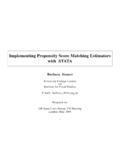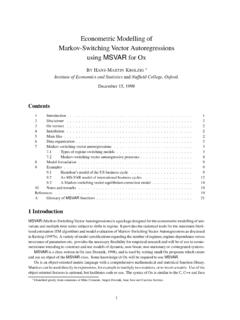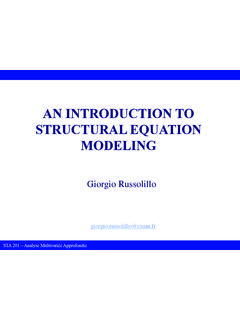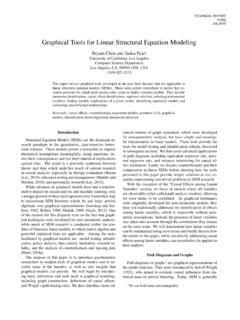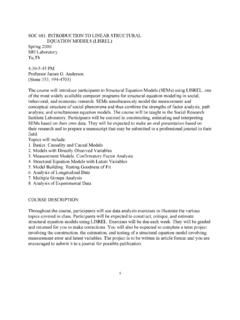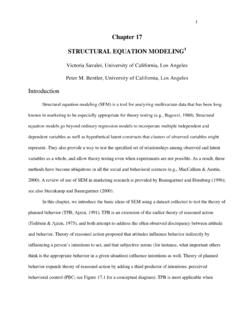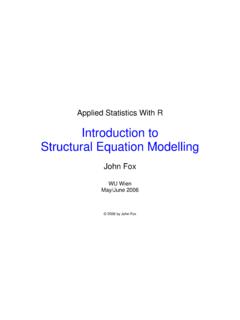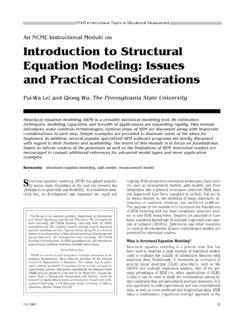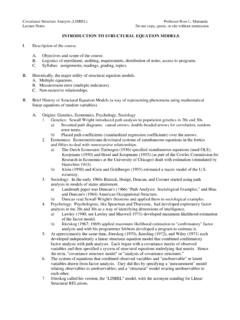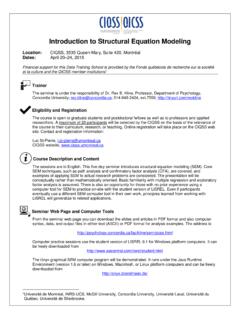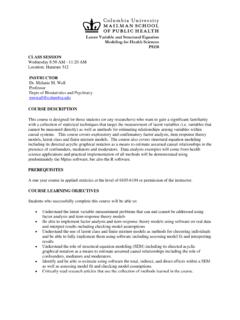Transcription of Introduction to SEM in Stata - fmwww.bc.edu
1 Introduction to SEM in StataChristopher F BaumECON 8823: Applied EconometricsBoston College, Spring 2016 Christopher F Baum (BC / DIW) Introduction to SEM in StataBoston College, Spring 20161 / 62 structural Equation Modeling in StataIntroductionIntroductionWe now present an Introduction to Stata ssemcommand, whichimplements structural equation modeling. Assemhas a very broad setof capabilities, we can only discuss a limited subset of its features andgive some illustrations of its use in the time available. We also will notdiscuss the graphical interface tosem, the SEM Builder, but you arewelcome to explore its capabilities for specifying the model graphicallyrather than in the command F Baum (BC / DIW) Introduction to SEM in StataBoston College, Spring 20162 / 62 structural Equation Modeling in StataIntroductionStructural equation modeling allows us to combinemeasurementmodels, which involve the relationships between observedmeasurements andlatent, or unobserved variables, withpath analysismodels that relate variables to their causal an applied econometrician, rather than a psychologist orsociologist, I found the terminology used in SEM to be quite foreign towhat we usually consider in economic modeling.
2 However, diggingdeeper, I recognize the F Baum (BC / DIW) Introduction to SEM in StataBoston College, Spring 20163 / 62 structural Equation Modeling in StataIntroductionFor instance, we motivate the use of the binomial probit model instudying behavior: for instance, whether or not someone makes apurchase. We argue that the individual is calculating the expected netbenefit of her action, which we cannot observe, but we observe theoutcome of their decision the expected net benefit is positive, we observe a 1; if it is negativeor zero, we observe a 0. In this case, expected net benefit is theunderlyinglatent variabledriving the decision process, and we canonly observe its presumed sign, not its magnitude. So the conceptsunderlying ameasurement modelare perhaps not as foreign as somemight F Baum (BC / DIW) Introduction to SEM in StataBoston College, Spring 20164 / 62 structural Equation Modeling in StataIntroductionWhat is apath analysismodel?
3 As it turns out, another terminology forthe sort of model used every day in applied econometrics, usually viasome sort of regression techniques. The model is comprised of one ormore equations (which, confusingly, are calledstructural equations )linking outcome variables (dependent variables, orendogenousvariables) with causal factors (independent variables, orexogenousvariables. In this context, all variables are presumed to be F Baum (BC / DIW) Introduction to SEM in StataBoston College, Spring 20165 / 62 structural Equation Modeling in StataIntroductionStructural equation models (SEM), then, combine these two types ofmodel and allow for both latent variables, driven by observables, andrelationships among observables. In that context, they often involveseveral equations , going beyond the common single-equationmodeling strategy employed in much of applied econometrics.)
4 But asStataCorp s developers have pointed out, the SEM frameworkencompasses most of the techniques in common use in appliedeconometrics, while providing a number of useful extensions to severalcommon F Baum (BC / DIW) Introduction to SEM in StataBoston College, Spring 20166 / 62 structural Equation Modeling in StataIntroductionThe scope of SEM is very well put by Stata s Introduction to SEM: structural equation modeling is not just an estimation method for aparticular model in the way that Stata sregressandprobitcommands are, or even in the way equation modeling is a way of thinking, a way of writing, anda way of estimating. ([SEM] 2).Christopher F Baum (BC / DIW) Introduction to SEM in StataBoston College, Spring 20167 / 62 structural Equation Modeling in StataIntroductionOne other tribal distinction in the application of SEM is a preferenceamong some tribes for working with these models graphicalrepresentations.
5 Stata s SEM Builder provides full support for thatstrategy, allowing you to both draw the model and express theinterrelationships in the diagram and then estimate the model asillustrated. The results of estimation are then displayed on the drawing,which can be produced in publication-quality my unfamiliarity with other SEM software, I cannot attest to theease of use or quality of output provided by SEM Builder relative tothat of competing products. I will not focus on the SEM Builderapproach in these talks, largely due to my own unfamiliarity with it andthat mode of working (I don t use menus, dialogs, etc. in working withStata, either). But for those who like to draw their models, I suggestthat Stata s facility for doing so is well worth F Baum (BC / DIW) Introduction to SEM in StataBoston College, Spring 20168 / 62 structural Equation Modeling in StataA classic SEMA classic example of SEM modelingTo motivate the full SEM framework, we present a classic example ofstructural equation modeling, as discussed by Acock inDiscoveringStructural Equation Modeling using is a model developedby Wheaton et al.
6 (Sociological Methodology 1977) to analyze theconcept of individuals revised edition of this book was published by Stata Press in F Baum (BC / DIW) Introduction to SEM in StataBoston College, Spring 20169 / 62 structural Equation Modeling in StataA classic SEMTwo latent variables are the object of investigation: alienation in 1967and alienation in 1971. A third latent variable, socioeconomic status(SES) in 1966, also plays a role in the model. The underlying datacontain information on two measures thought to reflect socioeconomicstatus: level of education and occupational status, both measured responses for two factors, anomia2and powerlessness, weremeasured in 1967 and again in 1971. Those are taken as indicators ofalienation. Additionally, as the key research question regards thestability of alienation, alienation in the earlier year (1967) is thought tohave a causal relationship with alienation in the later year (1971).
7 2A difficulty in remembering the meaning of F Baum (BC / DIW) Introduction to SEM in StataBoston College, Spring 201610 / 62 structural Equation Modeling in StataImplementing and estimating the modelTo illustrate this model graphically:SES66 Alien67 1 Alien71 2anomia67 3pwless67 4anomia71 5pwless71 6educ66 7occstat66 8 Christopher F Baum (BC / DIW) Introduction to SEM in StataBoston College, Spring 201611 / 62 structural Equation Modeling in StataImplementing and estimating the modelNote that capitalized variable names refer to latent variables, whilelower case names are observed variables. There are threemeasurement equations , for Alien67, Alien71, and SES66. Theobserved measures should reflect their respective latent , the arrows point to the observed measures. Alien67 is taken asrelated to SES66, and Alien71 is taken as depending on both Alien67and F Baum (BC / DIW) Introduction to SEM in StataBoston College, Spring 201612 / 62 structural Equation Modeling in StataImplementing and estimating the modelIn Stata s command language, this model can be specified as.
8 Use , clearsem ///(Alien67 -> anomia67 pwless67) /// measure Alien67(Alien71 -> anomia71 pwless71) /// measure Alien71(SES66 -> educ66 occstat66) /// measurement piece(Alien67 <- SES66) /// structural piece(Alien71 <- Alien67 SES66), /// structural piecestandardized // OptionsChristopher F Baum (BC / DIW) Introduction to SEM in StataBoston College, Spring 201613 / 62 structural Equation Modeling in StataImplementing and estimating the modelSEM can be used where we only have the summary statistics of thedata: means and their covariance (or correlation) matrix. In this model,we have 6 observed variables, or indicators. Their variance-covariancematrix (VCE) thus contains 6 (6+1) / 2 = 21 elements: 6 variances and15 covariances. The degrees of freedom of our estimated model willreflect the number of parameters to be estimated (variances of thelatent factors, variances of the error terms, and path coefficients).
9 Inthis context, with several parameters set to , we have 15parameters to be estimated, and thus 6 degrees of F Baum (BC / DIW) Introduction to SEM in StataBoston College, Spring 201614 / 62 structural Equation Modeling in StataImplementing and estimating the modelStata will consider that the indicators in the measurement model, aswell as the two latent alienation variables, are endogenous in theestimation, while SES66 is considered as an exogenous latentvariable, affecting each alienation variable but not being affected bythose F Baum (BC / DIW) Introduction to SEM in StataBoston College, Spring 201615 / 62 structural Equation Modeling in StataImplementing and estimating the modelWhether we estimate the model within SEM Builder or via thecommand language, we will get the same results:SES661 Alien67 F Baum (BC / DIW) Introduction to SEM in StataBoston College, Spring 201616 / 62 structural Equation Modeling in StataImplementing and estimating the sem ///> (Alien67 -> anomia67 pwless67) /// measure Alien67> (Alien71 -> anomia71 pwless71) /// measure Alien71> (SES66 -> educ66 occstat66) /// measurement piece> (Alien67 <- SES66) /// structural piece> (Alien71 <- Alien67 SES66), /// structural piece> standardized nolog // OptionsEndogenous variablesMeasurement: anomia67 pwless67 anomia71 pwless71 educ66 occstat66 Latent: Alien67 Alien71 Exogenous variablesLatent.
10 SES66 structural equation model Number of obs = 932 Estimation method = mlLog likelihood = ( 1) [anomia67]Alien67 = 1( 2) [anomia71]Alien71 = 1( 3) [educ66]SES66 = 1 Christopher F Baum (BC / DIW) Introduction to SEM in StataBoston College, Spring 201617 / 62 structural Equation Modeling in StataImplementing and estimating the modelOIMS tandardizedCoef. Std. Err. z P>|z| [95% Conf. Interval]StructuralAlien67 < .0344036 < .0396724 .5852523 ..0458162 < .0194328 .7747943 ..097363 < .0194466 .7738113 ..1158294 < .0193263 .8016337 ..09813 F Baum (BC / DIW) Introduction to SEM in StataBoston College, Spring 201618 / 62 structural Equation Modeling in StataImplementing and estimating the modelpwless71 <.






